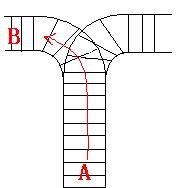Train Problem I
Time Limit : 2000/1000ms (Java/Other) Memory Limit : 65536/32768K (Java/Other)
Total Submission(s) : 75 Accepted Submission(s) : 23
Font: Times New Roman | Verdana | Georgia
Font Size: ← →
Problem Description
As the new term comes, the Ignatius Train Station is very busy nowadays. A lot of student want to get back to school by train(because the trains in the Ignatius Train Station is the fastest all over the world ^v^). But here comes a problem, there is only one railway where all the trains stop. So all the trains come in from one side and get out from the other side. For this problem, if train A gets into the railway first, and then train B gets into the railway before train A leaves, train A can't leave until train B leaves. The pictures below figure out the problem. Now the problem for you is, there are at most 9 trains in the station, all the trains has an ID(numbered from 1 to n), the trains get into the railway in an order O1, your task is to determine whether the trains can get out in an order O2.






Input
The input contains several test cases. Each test case consists of an integer, the number of trains, and two strings, the order of the trains come in:O1, and the order of the trains leave:O2. The input is terminated by the end of file. More details in the Sample Input.
Output
The output contains a string "No." if you can't exchange O2 to O1, or you should output a line contains "Yes.", and then output your way in exchanging the order(you should output "in" for a train getting into the railway, and "out" for a train getting out of the railway). Print a line contains "FINISH" after each test case. More details in the Sample Output.
Sample Input
3 123 321 3 123 312
Sample Output
Yes. in in in out out out FINISH No. FINISH
Hint
Hint
For the first Sample Input, we let train 1 get in, then train 2 and train 3.
So now train 3 is at the top of the railway, so train 3 can leave first, then train 2 and train 1.
In the second Sample input, we should let train 3 leave first, so we have to let train 1 get in, then train 2 and train 3.
Now we can let train 3 leave.
But after that we can't let train 1 leave before train 2, because train 2 is at the top of the railway at the moment.
So we output "No.".
For the first Sample Input, we let train 1 get in, then train 2 and train 3.
So now train 3 is at the top of the railway, so train 3 can leave first, then train 2 and train 1.
In the second Sample input, we should let train 3 leave first, so we have to let train 1 get in, then train 2 and train 3.
Now we can let train 3 leave.
But after that we can't let train 1 leave before train 2, because train 2 is at the top of the railway at the moment.
So we output "No.".
Author
#include<iostream> #include<string> #include<stack> using namespace std; int main() { string in,out; int num; while(scanf("%d",&num)!=EOF) { int record[25];//记录火车进出信息 int qwe=0;//代替序号 cin>>in>>out; int innum=0; int outnum=0;//记录对比到第几位 stack<char> s; s.push(in[innum++]); record[qwe++]=1; int as=0; while(as++<num*2&&innum!=outnum)//最多比较2*num次 { if(!s.empty()&&s.top()==out[outnum])//判断站有没有空 站顶与输出位置是否相同 { s.pop(); outnum++; record[qwe++]=0; if(s.empty()&&innum<num)//判断站有没有空 且 火车 进完 站没有 { s.push(in[innum++]); record[qwe++]=1; } continue; } else if(s.top()!=out[outnum])//站顶与输出位置不相同 火车进站 { if(innum<num)//进站 火车没用完 { s.push(in[innum++]); record[qwe++]=1; } else { if(!s.empty()&&outnum<num)//如果火车用完了 且 站不为空 且 火车没有出完 // 就代表卡死了 火车出不来 break; } } } if(outnum<num&&!s.empty()) { printf("No. FINISH "); } else { printf("Yes. "); for(int we=0;we<qwe;we++) { if(record[we]==0) { printf("out "); } else { printf("in "); } } printf("FINISH "); } } return 0; }
第一辆火车进站 如果如输出序列的头火车 不同
就下一辆火车进栈 ;
如果 栈顶火车 与 输出序列头火车相同 则说明 这火车 要出
如果 火车进完了 而且 栈顶火车 与 输出序列 不同 就说明 这辆火车 出不来
俗称 卡死;
这里要记录 比较次数 最多是 2*火车数 还要 记录 火车进栈数 和 输出序列头与栈顶火车的相同次数
如果 栈顶火车 与 输出序列头 相同则 火车出栈 输出序列 换头火车
输出序列可以用队列存储
栈顶火车与队头相同 火车出栈 队列出队;
如果栈为空 且 队列为空 这成功;
如果 所有火车都进过栈 队列不为空 则失败